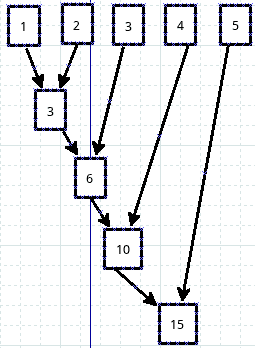reduce
>>> reduce(lambda x,y: x+y,[1,2,3,4,5])
15
请看官仔细观察,是否能够看出是如何运算的呢?画一个图:
还记得map是怎么运算的吗?忘了?看代码:
>>> list1 = [1,2,3,4,5,6,7,8,9]
>>> list2 = [9,8,7,6,5,4,3,2,1]
>>> map(lambda x,y: x+y, list1,list2)
[10, 10, 10, 10, 10, 10, 10, 10, 10]
对比一下,就知道两个的区别了。原来map是上下运算,reduce是横着逐个元素进行运算。
权威的解释来自官网:
reduce(function, iterable[, initializer])
Apply function of two arguments cumulatively to the items of iterable, from left to right, so as to reduce the iterable to a single value. For example, reduce(lambda x, y: x+y, [1, 2, 3, 4, 5]) calculates ((((1+2)+3)+4)+5). The left argument, x, is the accumulated value and the right argument, y, is the update value from the iterable. If the optional initializer is present, it is placed before the items of the iterable in the calculation, and serves as a default when the iterable is empty. If initializer is not given and iterable contains only one item, the first item is returned. Roughly equivalent to:
def reduce(function, iterable, initializer=None):
it = iter(iterable)
if initializer is None:
try:
initializer = next(it)
except StopIteration:
raise TypeError('reduce() of empty sequence with no initial value')
accum_value = initializer
for x in it:
accum_value = function(accum_value, x)
return accum_value
如果用我们熟悉的for循环来做上面reduce的事情,可以这样来做:
>>> lst = range(1,6)
>>> lst
[1, 2, 3, 4, 5]
>>> r = 0
>>> for i in range(len(lst)):
... r += lst[i]
...
>>> r
15
for普世的,reduce是简洁的。
为了锻炼思维,看这么一个问题,有两个list,a = [3,9,8,5,2],b=[1,4,9,2,6],计算:a[0]*b[0]+a[1]*b[1]+…的结果。
>>> a
[3, 9, 8, 5, 2]
>>> b
[1, 4, 9, 2, 6]
>>> zip(a,b) #复习一下zip,下面的方法中要用到
[(3, 1), (9, 4), (8, 9), (5, 2), (2, 6)]
>>> sum(x*y for x,y in zip(a,b)) #解析后直接求和
133
>>> new_list = [x*y for x,y in zip(a,b)] #可以看做是上面方法的分布实施
>>> #这样解析也可以:new_tuple = (x*y for x,y in zip(a,b))
>>> new_list
[3, 36, 72, 10, 12]
>>> sum(new_list) #或者:sum(new_tuple)
133
>>> reduce(lambda sum,(x,y): sum+x*y,zip(a,b),0) #这个方法是在耍酷呢吗?
133
>>> from operator import add,mul #耍酷的方法也不止一个
>>> reduce(add,map(mul,a,b))
133
>>> reduce(lambda x,y: x+y, map(lambda x,y: x*y, a,b)) #map,reduce,lambda都齐全了,更酷吗?
133
filter
filter的中文含义是“过滤器”,在python中,它就是起到了过滤器的作用。首先看官方说明:
filter(function, iterable)
filter() 函数用于过滤序列,过滤掉不符合条件的元素,返回由符合条件元素组成的新列表。
该接收两个参数,第一个为函数,第二个为序列,序列的每个元素作为参数传递给函数进行判,然后返回 True 或 False,最后将返回 True 的元素放到新列表中。
通过下面代码体会:
>>> numbers = range(-5,5)
>>> numbers
[-5, -4, -3, -2, -1, 0, 1, 2, 3, 4]
>>> filter(lambda x: x>0, numbers)
[1, 2, 3, 4]
>>> [x for x in numbers if x>0] #与上面那句等效
[1, 2, 3, 4]
>>> filter(lambda c: c!='i', 'hiekay') #能不能对应上面文档说明那句话呢?
'hekay' #“If iterable is a string or a tuple, the result also has that type;”
